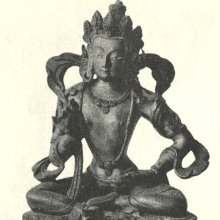Vajracakra, Vajra-cakra: 4 definitions
Introduction:
Vajracakra means something in Buddhism, Pali, Hinduism, Sanskrit. If you want to know the exact meaning, history, etymology or English translation of this term then check out the descriptions on this page. Add your comment or reference to a book if you want to contribute to this summary article.
Alternative spellings of this word include Vajrachakra.
Images (photo gallery)
In Hinduism
Shaktism (Shakta philosophy)
Source: Google Books: ManthanabhairavatantramVajracakra (वज्रचक्र) refers to the “adamantine wheel”, according to the Śrīmatottara-tantra, an expansion of the Kubjikāmatatantra: the earliest popular and most authoritative Tantra of the Kubjikā cult.—Accordingly, “(Mālinī) is endless, supreme, subtle, omnipresent and both supreme (transcendent) and inferior (immanent). The supreme energy (kalā), she is the goddess who is consciousness present in the End of the Twelve. She is the subtle energy (kalā) and, very subtle, she flows forth as the supreme (life-giving) nectar. Her form is (wonderfully diverse) like a peacock's tail and she resides in the Adamantine Wheel (vajracakra). [...]”.

Shakta (शाक्त, śākta) or Shaktism (śāktism) represents a tradition of Hinduism where the Goddess (Devi) is revered and worshipped. Shakta literature includes a range of scriptures, including various Agamas and Tantras, although its roots may be traced back to the Vedas.
In Buddhism
Tibetan Buddhism (Vajrayana or tantric Buddhism)
Source: academia.edu: The Structure and Meanings of the Heruka MaṇḍalaVajracakra (वज्रचक्र) refers to the “adamantine circle” positioned in the sahaja-puṭa or ‘innate layer’ of the Herukamaṇḍala: a large-scale and elaborate maṇḍala of Heruka, consisting of 986 deities, as found in the Ḍākārṇava chapter 15.—The Herukamaṇḍala consists of four layers (puṭa) consisting of concentric circles (cakra, totally one lotus at the center and 12 concentric circles, that is, 13 circles in total).
The vajracakra contains 36 pairs of Ḍākinī and Vīra (hero), collectively called Leader Heruka (Nāyakaheruka):
- Ḍākinī & Vajraḍāka,
- Lāmā & Viśvaḍāka,
- Khaṇḍarohā & Padmaḍāka,
- Rūpiṇī & Ratnaḍāka,
- Pracaṇḍā & Khaṇḍakapālin,
- Caṇḍākṣī & Mahākaṅkāla,
- Prabhāvatī & Kaṅkāla,
- Mahānāsā & Vikaṭadaṃṣṭrin,
- Vīramatī & Surāvairin,
- Kharvarī & Amitābha,
- Laṅkeśvarī & Vajraprabha,
- Drumacchāyā & Vajradeha,
- Airāvatī & Aṅkurika,
- Mahābhairavī & Vajrajaṭila,
- Vāyuvegā & Mahāvīra,
- Surābhakṣī & Vajrahūṃkāra,
- Śyāmādevī & Subhadra,
- Subhadrikā & Vajrabhadra,
- Hayakarṇā & Mahābhairava,
- Khagānanā & Virūpākṣa,
- Cakravegā & Mahābala,
- Khaṇḍarohā & Ratnavajra,
- Śauṇḍinī & Hayagrīva,
- Cakravarminī & Ākāśagarbha,
- Suvīrā & Heruka,
- Mahābalā & Padmanarteśvara,
- Cakravartinī & Vairocana,
- Mahāvīryā & Vajrasattva,
- Yāminī & Mahābala,
- Kāminī & Jñānaḍāka,
- Saṃcālanī & Dhairya,
- Trāsanī & Sthairya,
- Caṇḍikā & Mokṣa,
- Sarasvatī & Jñāna,
- Icchāsiddhi & Upāya,
- Mahājvālā & Cittavajra.
They each have one face and four arms; they hold a skull bowl, a skull staff, a small drum, and a knife; they and this circle is dark-bluish black in color.
Source: OSU Press: Cakrasamvara SamadhiVajracakra (वज्रचक्र) refers to the “vajra-circle” [i.e., oṃ vajra-cakre hūṃ], according to the Guru Mandala Worship (maṇḍalārcana) ritual often performed in combination with the Cakrasaṃvara Samādhi, which refers to the primary pūjā and sādhanā practice of Newah Mahāyāna-Vajrayāna Buddhists in Nepal.
Source: MDPI Books: The Ocean of HeroesVajracakra (वज्रचक्र) refers to the “adamantine circle”, according to the 10th-century Ḍākārṇava-tantra: one of the last Tibetan Tantric scriptures belonging to the Buddhist Saṃvara tradition consisting of 51 chapters.—Accordingly, “Now, furthermore, I shall explain this, the Heart Circle, outside the [Adamantine Circle] (vajracakra). [Deities reside] in the middles of the circle’s spokes colored in reddish-yellow, [...] The color [of their bodies] is the same as [the color of] the circle (viz., reddish-yellow). [...]”.

Tibetan Buddhism includes schools such as Nyingma, Kadampa, Kagyu and Gelug. Their primary canon of literature is divided in two broad categories: The Kangyur, which consists of Buddha’s words, and the Tengyur, which includes commentaries from various sources. Esotericism and tantra techniques (vajrayāna) are collected indepently.
See also (Relevant definitions)
Partial matches: Cakra, Vajra.
Query error!
Full-text (+81): Jnana, Vajrasattva, Candika, Candakshi, Subhadrika, Airavati, Dhairya, Sthairya, Kharvari, Drumacchaya, Surabhakshi, Cakravega, Shaundini, Cakravarmini, Cittavajra, Ratnavajra, Suravairin, Vajraprabha, Khandakapalin, Mahakankala.
Relevant text
Search found 4 books and stories containing Vajracakra, Vajra-cakra; (plurals include: Vajracakras, cakras). You can also click to the full overview containing English textual excerpts. Below are direct links for the most relevant articles:
Guhyagarbha Tantra (with Commentary) (by Gyurme Dorje)
Text 11.17 (Commentary) < [Chapter 11 (Text and Commentary)]
Introduction 3.2.2: The Sequence of the actual Foundation of Empowerment < [Chapter 9 (Text And Commentary)]
Agni Purana (by N. Gangadharan)
Architectural data in the Puranas (by Sharda Devi)
The different types of Temples < [Chapter 3 - Temples]
Arts in the Puranas (study) (by Meena Devadatta Jeste)
8. Temple Architecture < [Chapter 3 - Architecture in the Puranas]
